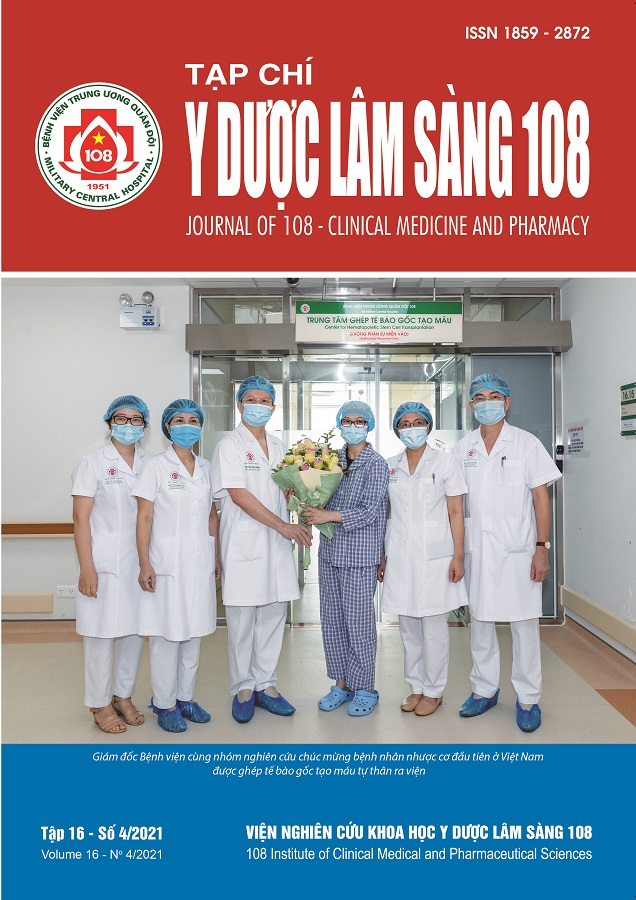Outcome evaluation of minimally invasive mitral valve replacement surgery at Hue Central Hospital
Main Article Content
Keywords
Abstract
Background: Minimally invasive cardiac surgery has been worldwidely and powerfully developed in both quantity and quality. In Vietnam, at Hue Central Hospital, we have recently performed minimally invasive surgical techniques in mitral valve replacement with promising outcomes. Objective: To evaluate the early outcomes of minimally mitral valve replacement (MIMVR) surgery via the right thoracotomy in our department. Subject and method: This is a descriptive study. All patients were diagnosed as mitral stenosis and mitral regurgitation, and underwent MIMVR at Hue Central Hospital from December 2016 to December 2019. Patients were postoperatively followed up and assessed by clinical examination and echocardiography within 3 months. Result: 56 patients underwent MIMVR surgery, the male-female ratio was 1: 2.1; the mean age was 44.5 ± 12.5 years old; Preoperative functional symptom: NYHA grade I-II in 66.1%. Mean MVA was 1 ± 0.6cm2; mean LVEF was 63.2 ± 5.4%; mean PAPs was 43.3 ± 18.3mmHg. Mean aortic cross-clamping and mean CPB time time was 95.8 ± 16.6 minutes and 130.2 ± 27.9 minutes respectively; mean mechanical ventilation time was 3.4 ± 1.3 hours; mean ICU time was 5.9 ± 1.8 days. No hospital death; 3.6% of postoperative bleeding needed
re-operation. The mean VAS score of the 2nd day was 2.9 ± 0.8 and of 3rd day was 2.2 ± 0.8. In a 3 month follow-up, 73.6% were NYHA grade I - II; mean LVEF was 62.9 ± 3.7%; mean PAPs was 31.7 ± 3.7mmHg; there were no re-operation needed and no mortality during the following time. Conclusion: MIMVR surgery at Hue Central Hospital was safe and effective, significantly improved clinical symptoms as well as postoperative pain.
Article Details
References
2. Phạm Thành Đạt, Đoàn Quốc Hưng, Nguyễn Công Hựu, Lê Ngọc Thành (2019) Phương pháp bộc lộ van hai lá trong phẫu thuật sửa van hai lá nội soi tại Trung tâm Tim mạch Bệnh viện E. Phẫu thuật Tim mạch và Lồng ngực Việt Nam, 26, tr. 26-30.
3. Dương Đức Hùng (2016) Phẫu thuật tim ít xâm lấn: Lựa chọn thế nào trong điều kiện Việt Nam?. Hội nghị Tim mạch toàn quốc 2016.
4. Nguyễn Công Hựu, Phan Thảo Nguyên, Đỗ Anh Tiến và cộng sự (2014) Phẫu thuật tim hở ít xâm lấn với nội soi hỗ trợ tại Trung tâm Tim mạch, Bệnh viện E: Những kinh nghiệm ban đầu qua 63 bệnh nhân phẫu thuật. Phẫu thuật Tim mạch và Lồng ngực Việt Nam, 7, tr. 24-28.
5. Trần Thanh Thái Nhân, Trần Hoài Ân, Nguyễn Thục, Trần Như Bảo Lân (2018) Phẫu thuật tim hở ít xâm lấn với nội soi hỗ trợ tại Trung tâm Tim mạch Bệnh viện Trung ương Huế: Những đánh giá ban đầu. Phẫu thuật Tim mạch và Lồng ngực Việt Nam, 20, tr. 108-113.
6. Đặng Hanh Sơn (2011) Nghiên cứu đánh giá kết quả phẫu thuật thay van hai lá bằng van nhân tạo cơ học Sorin tại Bệnh viện Tim Hà Nội. Luận án Tiến sỹ y học, Học viện Quân y.
7. Lê Ngọc Thành (2018) Phẫu thuật tim hở nội soi: Thực trạng và triển vọng tại Việt Nam. Trung tâm Tim mạch Bệnh viện E.
8. Chitwood WR, Wixon CL, Elbeery JR, Moran JF, Chapman WHH, Lust RM (1997) Video-assisted minimally invasive mitral valve surgery. The Journal of Thoracic and Cardiovascular Surgery 114(5): 773-782.
9. Daniel P, José LP (2017) Contemporary results in minimally invasive mitral valve surgery. Minimally invasive mitral valve surgery, 1st ed, Nova Biomedical, New York, Chapter 14: 313-332.
10. Falk V, Walther T, Autschbach R, Diegeler A, Battellini R, Mohr FW (1998) Robot-assisted minimally invasive solo mitral valve operation. The Journal of Thoracic and Cardiovascular Surgery 115(2): 470-471.
11. Glower D (1998) Mitral valve operation via Port Access versus median sternotomy. European Journal of Cardio-Thoracic Surgery 14: 143-147.
12. Iribarne A, Russo MJ, Easterwood R et al (2010) Minimally invasive versus sternotomy approach for mitral valve surgery: A propensity analysis. Ann Thorac Surg 90(5): 1471-1477.
13. Felger JE, Chitwood WR, Nifong LW, Holbert D (2001) Evolution of mitral valve surgery: Toward a totally endoscopic approach. The Annals of Thoracic Surgery 72(4): 1203-1209.
14. Mattia G, Antonio L, Antonio M, Eugenio Q (2017) Mini-thoracotomy mitral valve repair. Minimally invasive mitral valve surgery, 1st ed, Nova Biomedical, New York, Chapter 8: 155-177.
15. Modi P, Hassan A, Chitwood WR (2008) Minimally invasive mitral valve surgery: A systematic review and meta-analysis. Eur J Cardiothorac Surg 34(5): 943-952.
16. Sundermann SH, Sromicki J, Rodriguez HCB et al (2014) Mitral valve surgery: Right lateral minithoracotomy or sternotomy? A systematic review and meta-analysis. J Thorac Cardiovasc Surg 148(5): 1989-1995.
17. Vleissis AA, Bolling SF (1998) Mini-reoperative mitral valve surgery. J Card Surg 13(6): 468-470.
18. Walther T, Falk V, Metz S et al (1999) Pain and quality of life after minimally invasive versus conventional cardiac surgery. The Annals of Thoracic Surgery 67(6): 1643-1647.
19. Müller L et al (2018) Indications and contra-indications for minimally invasive mitral valve surgery. Journal of visualized surgery 4: 255.
 ISSN: 1859 - 2872
ISSN: 1859 - 2872
